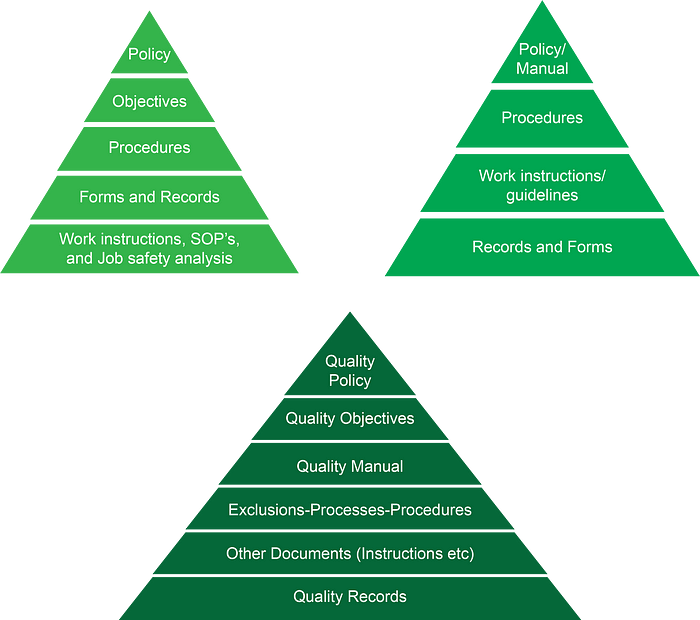
Let us remind ourselves…
ISO 9001 is the international standard that comprises requirements for a quality management system (QMS) that an organization must meet in order to comply with its internationally recognized standards.
In the beginning, the biggest struggle is the misunderstanding and confusion of terms such as Process, Procedure, and Work Instruction (Standard Operating Procedures — SOP), so let’s start with basics:
PROCESS — what needs to be done and why
PROCEDURE — how the process needs to be done
WORK INSTRUCTION — how to carry out the procedure.
It’s important to know there is a hierarchy to the documentation. That helps with the understanding of the documentation and to think about each stage down getting more detailed than the previous stage.
While browsing the internet, you can come across various graphics that represent a hierarchy of documentation. Here are some I singled out:

Documentation hierarchy
Would you understand graphics like this? Can you find processes in the hierarchy?
For a better understanding, I will present you with a simpler graphic referring to our topic:

Processes
A process document defines a process in a broader sense. They do not need to contain details and they should have objectives that you should be able to measure. The documents must contain the expected inputs and outputs, the required resources, and key activities.

Procedures
How to perform a process is explained in the procedure. It usually contains elements like why the procedure is required; what and how needs to be done; who performs what action; where the inputs come from and where the outputs go; tools, information, or other resources required; terminology, definitions, etc.
The procedure is unnecessary if it doesn’t matter how the process will be conducted.
A procedure has enough information to explain how you run your organization, how you control things, and what the checks are, and of course, ensure that you meet the requirements of ISO 9001:2015.
A procedure offers a general description of how the company meets the requirements of the process but does not include details specific to execution.
Work Instruction
The next stage, with more details, is Work Instruction. A work instruction describes how to perform a task within a process.
The reasons for work instructions is that they are organizational and explanatory:
- A more detailed description is needed than in the procedure. Most organizations contain instructions on how to perform certain activities in detail. Those things can be specific tasks referenced in a procedure, aid in training, etc. It also can contain tasks to reduce mistakes.
- There can be effective segregation between procedure and work instruction. If you approach it as a good organizational tool–then there is an advantage to divide up procedure(s) into many “sub-procedures” that are related but cover individual aspects.
To describe where it fits into the process, the work instructions will often repeat many elements of the procedure such as:
- Purpose
- Definitions
- Responsibility
- Requirements
- Tools and information
A work instruction contains a gradual detail that is not helpful to put into a procedure because it requires such a limited scope.
If you want to read more anything related to this topic, feel free to comment below 😊